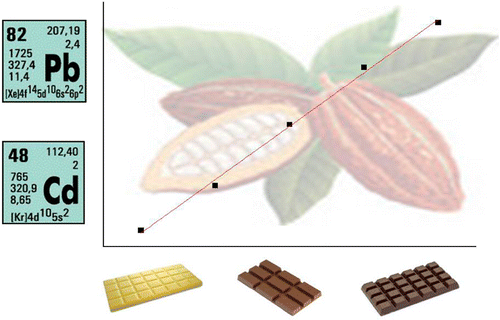Lead and cadmium found in some chocolate bought in Brazil

Scientists have found that commercial samples of chocolate purchased in Brazil contain varying levels of lead and cadmium, which can cause health problems, and that those levels are linked to how much cocoa a product contains. They reported their findings, which could have health implications—particularly for children—in ACS' Journal of Agricultural and Food Chemistry.
Solange Cadore and colleagues note that chocolate has many potential health benefits due to the high levels of flavonoids and antioxidants in its star ingredient, cocoa. But they also explain that other research has suggested that unwanted components can make their way into the delectable treat. Past studies have shown that crops can take up lead and cadmium—two naturally occurring metals. Lead can cause abdominal pain, headaches and anemia in adults.
In children, it can cause behavioral changes and language delay, among other problems. Cadmium can cause damage to several organs. It also has estrogen-like effects and disrupts some hormones. Concerned that chocolate could contain lead and cadmium, Cadore's team set out to analyze commercial samples for the metals.
The researchers tested 30 milk, dark and white chocolate products bought in Brazil. Most were Brazilian brands, some of which are also sold in the U.S. They found that dark chocolates had the highest amounts of lead and cadmium, but all levels fell below maximum consumption limits from Brazil, the European Union (E.U.) and the World Health Organization. The U.S. Food and Drug Administration, however, recommends that the level of lead in candy should not exceed 100 nanograms per gram (ng/g) of candy—two samples topped this threshold by about 30 to 40 ng/g.
With respect to cadmium, the researchers calculated that if a child weighing 33 pounds eats about a third of an ounce of chocolate a day (less than a quarter of a regular chocolate bar), that child would consume a maximum of 20 percent of the E.U.-suggested tolerable weekly intake of the metal. The researchers point out that only a fraction of lead or cadmium would absorb into a person's bloodstream, but the levels they found in dark chocolate were still concerning, they concluded.
More information: "Cadmium and Lead in Chocolates Commercialized in Brazil" J. Agric. Food Chem., 2014, 62 (34), pp 8759–8763. DOI: 10.1021/jf5026604 Abstract
Abstract
Cadmium (Cd) and lead (Pb) concentrations and their relationship to the cocoa content of chocolates commercialized in Brazil were evaluated by graphite furnace atomic absorption spectrometry (GF AAS) after microwave-assisted acid digestion. Several chemical modifiers were tested during method development, and analytical parameters, including the limits of detection and quantification as well as the accuracy and precision of the overall procedure, were assessed. The study examined 30 chocolate samples, and the concentrations of Cd and Pb were in the range of <1.7–107.6 and <21–138.4 ng/g, respectively. The results indicated that dark chocolates have higher concentrations of Cd and Pb than milk and white chocolates. Furthermore, samples with five different cocoa contents (ranging from 34 to 85%) from the same brand were analyzed, and linear correlations between the cocoa content and the concentrations of Cd (R2 = 0.907) and Pb (R2 = 0.955) were observed. The results showed that chocolate might be a significant source of Cd and Pb ingestion, particularly for children.
Journal information: Journal of Agricultural and Food Chemistry
Provided by American Chemical Society

















